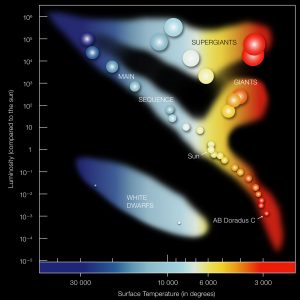Main sequence stars are the most plentiful in the universe. About 90% of the visible stars in a typical view of the night sky are on the main sequence. This corresponds with the fact that most stars spend 90% of their life on the main sequence. Members in this community range from one tenth solar mass to 200 solar masses. The term “main sequence” refers to the area on the Hertzsprung-Russell Diagram (which is described in more detail below).

Source: European Southern Observatory – 19th June 2007.
When a star initiates its hydrogen-burning phase, we say that it is entering the main sequence and is a true star—not a protostar, brown dwarf, nor a planet. The main sequence is a diagonal line plotted on the H-R diagram, which represent stars that are burning hydrogen, and fusing it into helium. The fusion process in the core releases heat and light, supporting the star against further gravitational collapse, and making it shine. Stars spend most of their life in one spot on the main sequence. Very massive stars live at the top of the main sequence, shining very blue and very bright, while low-mass stars are dim and red and live towards the bottom right. The sun is between these two extremes.
Examples of main sequence stars
Examples of main sequence stars include: Fomalhaut, Proxima Centauri, Regulus and Sirius.
Mass
As we have seen mass is the key determinant of how a star lives and behaves. Astronomers use a simple unit, the solar mass, which is equal to the mass of our sun, to compare the size of stars. About 90 percent of the stars in the universe, including the sun, are main sequence stars. The table shows the initial mass of a protostar and the expected outcome.
| Viability of a protostar | ||
|---|---|---|
| Solar mass | Chief prospect | |
| <0.08 | There is no fusion possible | Brown dwarf - a dud |
| 0.10 - 99 | The basic range required for the viability of a star | Main sequence star with a long stable life |
| >100 | Above this mass the material is far too unstable | Short life leading to supernova |
Old stars
Old stars include low mass main sequence stars that came into existence billions of years ago and also some high mass stars that will explode as supernova after existing for less than a million years. They include giants and supergiants. Most old stars lie outside the main sequence. They are old in the sense they are reaching end of life. For example, while Betelgeuse is about 8.8 million years old, and Pollux is 724 million years old, they are both “old”.
Regor is a blue subgiant that is leaving the main sequence. It has surface temperature of about 35 000°C and a solar mass of 30. It is in a close orbit with a binary partner, a Wolf-Rayet star. Barnard’s Star and Proxima Centauri are both cool red dwarfs on the main sequence. They are both flare stars. That is to say, they undergo a dramatic and sudden increase in brightness for a short period. Proxima Centauri is the nearest star to Earth after our sun.
| Notable stars off the main sequence | |||||
|---|---|---|---|---|---|
| Supergiants | Colour | Type | Current age | Temperature | Solar mass |
| Eta Carinae | Blue supergiant | B0 | 3 million years | 37 000°C | >100 |
| Rigel | Blue supergiant | B8 | 8 million years | 12 100°C | 21 |
| Deneb | Blue supergiant | A | Uncertain | 8 500°C | 19 |
| Canopus | Blue-white supergiant | F | 25 million years | 7 400°C | 8 |
| Betelguese | Red supergiant | M | 8 million years | 3 500°C | 12 |
| Antares | Red supergiant | M | 15 million years | 3 600°C | 15 |
| Giants | |||||
| TT Cygni | Red giant | G | Uncertain | 3 200°C | |
| Polaris A | Yellow giant | F7 | 70 million years | 5 700°C | 4.5 |
| Aldebaran | Orange giant | K5 | Uncertain | 3 727°C | 1.7 |
| Arcturus | Orange giant | K0 | 7 billion years | 4 000°C | 1.1 |
| Pollux | Yellow-orange giant | K0 | Uncetain | 4 600°C | 1.9 |
| White dwarfs | |||||
| Sirius B | White dwarf | DA2 | Uncertain | 25 200°C | 0.98 |
| Procyon B | White dwarf | DQZ | 724 million years | 7 740°C | 0.6 |
Back to Top
By Nigel Benetton, science fiction author of Red Moon Burning and The Wild Sands of Rotar.
Last updated: Wednesday, 3rd March 2021